The Complete Guide to Red Light Therapy for Weight Loss
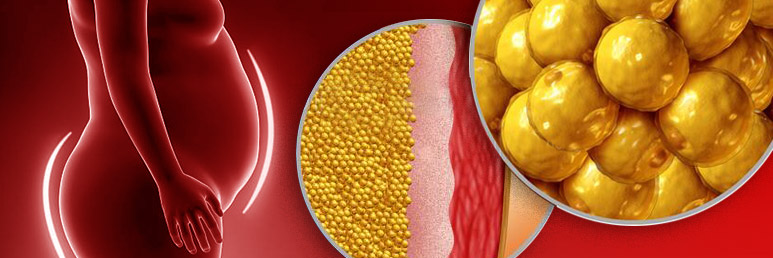
Red and near infrared light therapy are novel tools for weight loss and body sculpting. Does it really work?
Given the plethora of products and equipment available in the market today that claim, often falsely, to aid weight loss or fat loss, it is prudent to be highly skeptical of anything that makes this claim. So when we say that light therapy can help improve fat loss (and even preserve/boost lean mass), what is the evidence and mechanism?
Contents
What is it?
Mechanism
Targeting fat
Belly fat
Subcutaneous fat
Cellulite
Drawbacks
Summary
References
Further Reading
Leave a comment
What is light therapy?
Light therapy is known by many names. The formal scientific name is photobiomodulation (previously known as LLLT). Other names include LED therapy, red light therapy, infrared light therapy, LED phototherapy, low level laser therapy, low level light therapy, laser therapy, cold laser, and more.
This type of health therapy is not new, and is in fact well established for treating various health issues. However its use for weight loss and fat loss specifically is new, with most research being done in the last 20 years.
All it involves is the application of certain wavelengths of red and near infrared light to the body. You just shine the light from a suitable LED light source onto your skin.
Sounds easy, right?
There’s a bit more involved if you want to get tangible weight loss results. In this article we will explain everything you need to know to get fat loss results anywhere in the body.
How can light aid weight loss?
Light therapy, and even just exposure to natural sunlight, has always anecdotally made people feel healthier and more energetic. The wholesome benefits of light are highlighted by the fact that many pre-historic cultures worshipped the sun.
The positive influence of sunlight can’t solely be accounted for by vitamin D production in the skin; in fact a more significant and important effect comes from how red and near-infrared light interact with our cells.
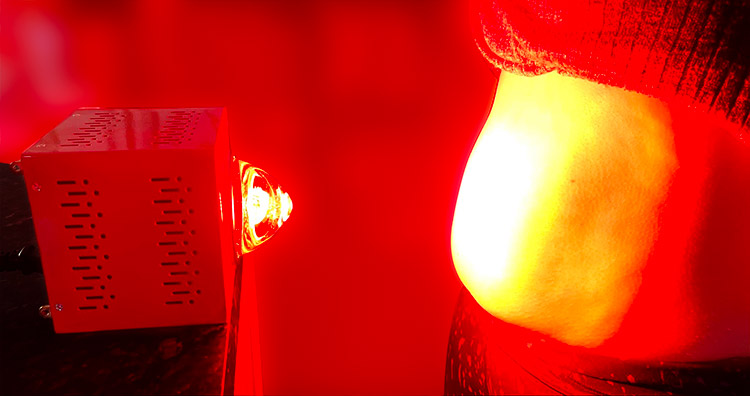
These wavelengths of light from 600-1000nm have direct effects on the metabolism of the body by interacting with the energy producing parts of our cells. As energy intake and output are inextricably linked to weight management, the link is clear.
Mechanism
Bioenergetics
The mechanism of red light therapy for weight loss is quite simple – it increases metabolic rate. As mentioned in our descriptions of red and infrared light, light therapy stimulates our mitochondria (the cell’s power source) to increase glucose oxidation.
This is because light between 600nm and 1000nm stimulates a key copper enzyme in our cells. This inevitably results in more ATP, or cellular energy, being produced.
More glucose burned efficiently means less stress, and healthier cells, which results in a stronger metabolic rate – ultimately leading to fat loss. This effect can be seen in muscle tissue, as well as fat.
While other agents such as thyroid hormone have a similar ATP enhancing effect, this red light driven oxidative metabolism (efficiently turning glucose into carbon dioxide) is the key principle in keeping a high metabolic rate, as opposed to the stress metabolism of cortisol, adrenaline, free fatty acids, etc.
It has been shown scientifically for over 50 years that prolonged dieting and stress lowers the metabolic rate. In one controlled study, long term dieters were shown to have a stable weight on only 700 calories a day, whereas a healthy metabolic equilibrium is more like 3000 calories eaten and burned a day.
Anyone who has been on repeated low calorie or other diets, or been through periods of stress, will have a diminished metabolic rate. Red and infrared light helps to work against this, providing a healthy boost to energy, and a buffer against stress. By using red light therapy, your body will burn more calories.
Blood flow
In addition to the metabolic boost we see, red and infrared light also improves blood flow in the area it is applied.
This vasodilatory effect is due to several factors – red light wavelengths will photodissociate (remove) nitric oxide molecules from respiratory enzymes, and also improve carbon dioxide production from respiration.
Both of these molecules (NO and CO2), when in the blood, have a significant effect on improving blood flow. This means that cells cannot only produce more energy, but also have more blood flow providing essential nutrients like glucose and oxygen.
Fat tissues in our body have limited access to blood, so improving blood flow through the different layers of fat is essential to helping it burn off.
Types of fat: White fat vs Brown fat
While fat tissues may be distributed in different places around the body, they can also vary in their internal structure, with some being for storing calories and some being calorie burning:
White Fat
White fat refers to adipose tissue cells composed almost entirely of triglycerides (fat), with very few other cellular components, mostly just a few mitochondria. These type of fat cells are used for storing calories/energy. The white color is from the high amount of fat stored inside. Other terms for white fat include ‘White Adipose Tissue‘ and WAT.
Mitochondria in the fat cells are the main target of light therapy. Light therapy helps these mitochondria to use calories faster – consuming and burning that fat stored in the white fat cell. As a result, the size of the white fat cell decreases. In the short term this is how red light therapy can help you to lose weight, but light therapy can also help you to keep the weight off, due to brown fat cells:
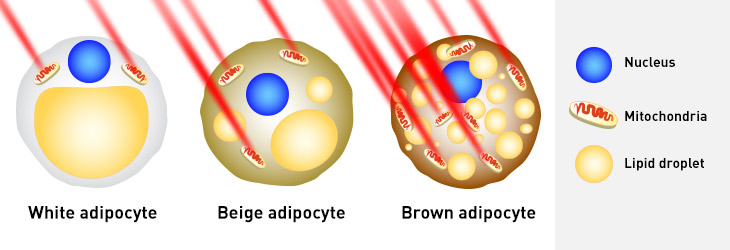
Brown Fat
Brown fat refers to adipose tissue cells that have less triglycerides and more mitochondria. Brown fat (also known as BAT – brown adipose tissue) cells can burn through calories at a fast rate – turning fat into heat – a process known as thermogenesis. They help you to stay warm in cold conditions, and to not gain weight in normal conditions. The brown color is from the high amount of mineral-rich mitochondria.
Newborn babies and hibernating animals have higher levels of brown fat (referred to as ‘good fat’ by some). Overweight and obese adults have higher levels of white fat. Losing white fat (or changing white fat into brown) is the key to weight loss.
Read more about how brown fat affects your metabolism here.
Can light therapy turn white fat into brown fat?
In the short term
One of the key effects of red light therapy on cells is to increase the amount of energy produced. This has immediate benefits to metabolism and weight loss.
A light therapy session will boost energy production (and consumption) in both white and brown fat cells, burning away the fats.
In the long term
A longer term, and not so well known, effect of light therapy is something called mitochondriogenesis – the creation of new mitochondria (also known as mitochondrial biogenesis). Red light therapy creates a positive feedback cycle, whereby the increased energy production leads to more mitochondria, which further increases energy production, and so on.
It is possible that light therapy may help to transform white fat into brown, however more research is needed to see if this is the case.
Spot fat loss
So-called spot reduction fat loss (targeting one area you want to lose fat, such as abs, buttocks) or ‘body contouring’ is commonly viewed as a myth amongst most health and fitness experts.
Those that do accept it see the impact as negligible – basically most people lose fat evenly around their body, even if they primarily exercise one area (i.e. you only get a 6-pack by having a low overall body fat, in addition to doing sit-ups and other core exercises every day).
The vasodilatory & pro-metabolic effects of red and infrared light provide a new mechanism for spot reduction in fat, providing a specific localised boost in metabolism, and in fact there are studies showing this.
Locations of body fat that light therapy can target
There are various types of fat tissues in the body, both in terms of the structure/composition of the fat cells themselves and also the position within the body. Below is a summary of the main locations of fat and their relevance to light therapy:
Abdominal fat / visceral fat
Abdominal and visceral fat are terms used for what most people would call belly fat. It is what gives the protruding ‘pot belly’ or ‘beer belly’ look and large waist size.
Getting rid of it is essential to having a flat stomach and also for health reasons – visceral fat is linked to many chronic diseases.
High levels of this abdominal belly fat are linked to insulin resistance, type 2 diabetes, high blood pressure, heart disease and more. You can read more about this here.
This type of fat is stored deep inside the body, surrounding the internal organs like the liver, intestines and kidneys.
How to lose belly fat with light therapy
Being deeper inside the body poses a problem for light therapy – the light has to pass through the skin, then the subcutaneous layer, the abdominal muscles and then potentially through organs like the intestines, just to reach it.
Only a very small percentage of light applied to the skin will get down this far. Two key factors are required to ensure enough light can reach:
- A high light intensity – When you consider that only a small percentage of the light will reach the visceral fat tissue, applying light from a very strong device is the most essential factor. A light intensity of at least 100mW/cm2, but preferably 200mw/cm2 or higher is needed.
- The most penetrative wavelength – Different wavelengths of light have different penetration potential. Near infrared penetrates deeper than red, which penetrates deeper than orange, which goes deeper than yellow and green, etc. Near infrared around 730 – 840nm has the best penetration potential but the absolute best penetration is the 740-760nm range. This type of light penetrates so well that it is known as the Near Infrared window (into biological tissue). Some longer near infrared wavelengths around 1100nm also penetrate well, but don’t have the same metabolic effects on our cells, so they are not useful for light therapy.
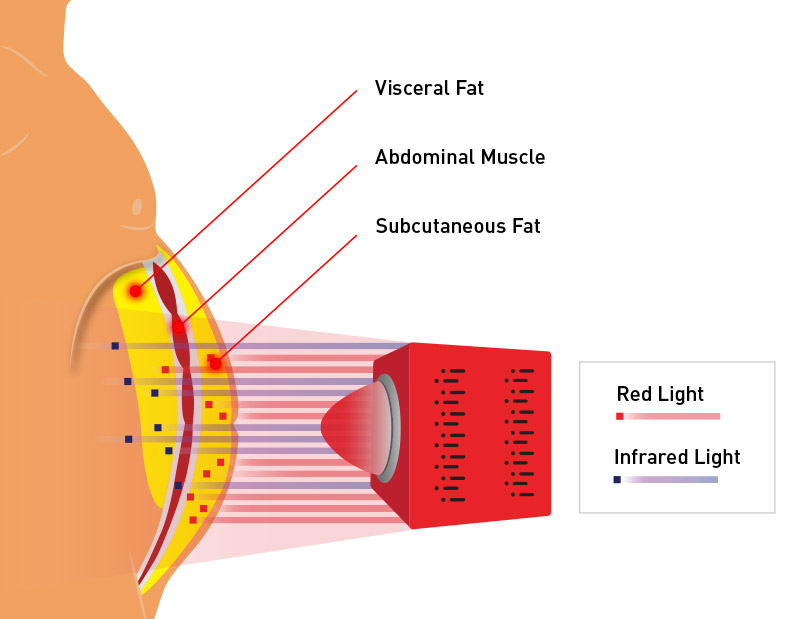
Subcutaneous fat
Subcutaneous means ‘under the skin’ – the main place in our bodies where fat is stored. Read about subcutaneous fat in general here.
Around 90% of fat in the average human body is in the form of subcutaneous fat and includes everything from the fat in the legs (including cellulite) and arms, to buttocks, ‘muffin tops’, ‘love handles’, neck, chest, back and face fat.
A good amount of belly fat is also subcutaneous – although it depends on the person. Subcutaneous fat gives a softer, ‘flabby’ consistency to the body, whereas the deeper visceral fat gives a harder ‘pot belly’ because it pushes up against the abs.
Subcutaneous fat, in normal amounts, is not considered as much as a health issue as deeper belly fat, but is considered unsightly and gives a smoother appearance to the body – hiding the definition of muscles, veins and structures of the body.
Losing subcutaneous fat is key to achieving a visible ‘six-pack’ stomach, as well as removing cellulite, muffin tops and other unwanted features.
How to lose subcutaneous fat with light therapy
As subcutaneous fat is quite close to the surface of the body, it is readily available to the wavelengths used in light therapy. The light has to pass through the epidermis and dermis layers of the skin to reach this subcutaneous (also known as hypodermis) layer.
Penetration through the top layers of skin is achieved with a red or near infrared light of suitable intensity.
As subcutaneous fat is distributed over large areas of the body, using a light device that can emit suitable intensity/wavelength light, evenly, over that same large area is important.
The 2 essential factors when using a light therapy device for subcutaneous fat loss are:
- A moderate light intensity over a large area – light intensity (or power density) generally gets weaker as the distance from the light source increases. At the same time the area that is covered by the light increases. Ensuring a balance between area covered and light intensity is key to affecting the subcutaneous fat across your body. You should be aiming for around 50mW/cm2 of light intensity or higher to get effects in subcutaneous fat.
- A combination of wavelengths – as the subcutaneous layer can be quite large, depending on the amount and type of adipose tissue, a combination of wavelengths works best to cover all depths evenly. Near infrared penetrates more readily, so it can be useful to affect the deeper part of the hypodermis. Red light can penetrate through the skin, but doesn’t go quite as deep as near infrared, so is ideal for effects in the fat cells directly under the dermis.
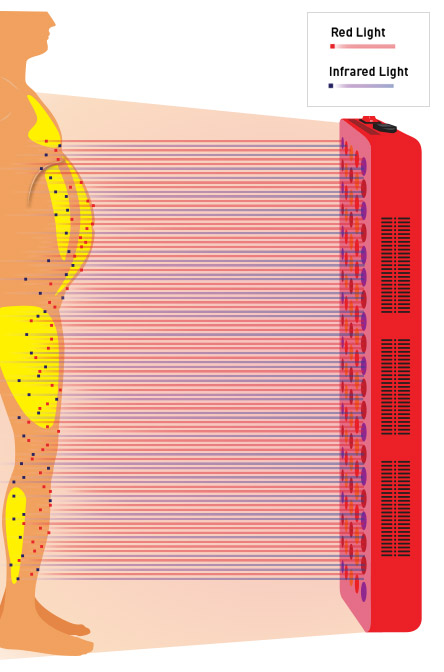
Cellulite
Cellulite is a dimpled, lumpy appearance of skin, typically seen around the buttocks and thigh area. Also known as ‘orange-peel skin’, ‘cottage cheese skin’ and ‘mattress phenomenon’, it is common in both men and women (and even babies).
It is not considered a health risk or associated with any health conditions, but is considered by many to be unsightly.
Cellulite is graded by its severity, with grade 1 being mild cellulite, 2 being moderate and grade 3 being severe.
It occurs when the subcutaneous fat tissues push up against the lower layers of our skin, unevenly. So it is a sub-type of subcutaneous fat.
Does red light therapy help cellulite?
Red light therapy has been studied extensively to discover what effect it might have on the appearance of cellulite.
Given the effects that red and near infrared light have on spot fat loss, in addition to improving skin texture, light therapy seems an obvious choice to improve cellulite.
Most studies looking at the effects of red light on cellulite combined red light with near infrared. This approach gives a broader spectrum of light and provides even effects across a range of depth of tissue.
The red light provides structural health improvements in the epidermis and dermis parts of the skin, while some more of the red, and especially the near infrared, can penetrate more readily, to the subcutaneous layer, providing metabolic benefits there.
The results of most studies indicate a reduction in the ‘severity’ score of cellulite (so the cellulite changes from ‘moderate’ to ‘mild’, or ‘mild’ to no cellulite at all), but they also note the need for maintenance treatments.
Drawbacks and limitations
As with any therapy, being aware of potential drawbacks is important before you start. What are the drawbacks you can expect?
- The results from light therapy alone, without any other changes in diet or lifestyle whatsoever, are not likely to be transformational.
- Light therapy won’t stop you gaining weight if everything else in your life is pushing for that to happen.
- Light therapy requires patient, consistent application. It takes at least weeks and even months before results are apparent. You’ll need several sessions per week.
- For fat across large areas of the body, a large, powerful and somewhat expensive light therapy device will be necessary.
Summary
- Light therapy has been studied for weight loss effects for around 20 years
- A combination of both red and near infrared light is ideal
- There is placebo controlled evidence that it does help to a moderate degree
- Red and near infrared light of appropriate wavelengths affects the mitochondria inside fat cells
- The fat cells burn through calories faster after a light therapy session
- Light therapy can help both subcutaneous fat and deeper visceral belly fat
- Deeper belly fat requires a very intense light source
- Subcutaneous fat requires a moderate light intensity but over a large treatment area
- LEDs are the only light technology devices that are well studied.
References
- A recent study by the University of Sao Paulo (Sene-Fiorese. 2015) showed a doubling of the rate of fat loss when combined with light therapy. The light used was infrared and applied immediately after weight training.
- Another study in 2014 (Kathryn J. Reid et al.) measured average light exposure and body weight, as well as other specifics such as light timing. They showed how light as a positive influence of weight, regardless of sleep quality.
- In 2012 a study by Mariana G. Figueiro et al. examined the effects of red, green and blue light on the hunger hormones leptin and ghrelin. Red and green were the wavelengths found to reduce hunger hormones in sleep deprived individuals – blue did not.
- A 2013 review of body contouring (basically a non-invasive alternative to liposuction) using red light concluded that it is “effective in reducing overall body circumference measurements of specifically treated regions, including the hips, waist, thighs, and upper arms, with recent studies demonstrating the long-term effectiveness of results”.
- A 2006 study was performed by Frank Möckel et al. involving obese women exercising on a stationary bike whilst also receiving orange, red and infrared light to areas such as waist, hip, and thighs. The effects were compared to a group that still exercised, but received no light. Body weight and hip/waist/thigh measurements were significantly decreased in the light group compared to the control.
- A 2007 randomized, double-blinded study by Sasaki et al. looked at how a combination of red and near infrared light could help the appearance of thigh cellulite. At the end of the study period, 90% of the women had their cellulite severity downgraded (it looked better) to a lower level.
Further reading
Thyroid – Improvements to thyroid function have systemic effects across the entire body in terms of metabolic rate. One of the main symptoms of low thyroid function is fat gain. Recent research points to near infrared light therapy being a useful therapy for correcting sub-optimal thyroid function. You can read about that here: Light Therapy For Hypothyroidism
Muscles – Human skeletal muscles are thought to burn through 10-15 calories per kilogram per day – even if you don’t do anything with them. Increasing your muscle mass therefore increases your daily calorie expenditure and can help with weight loss. Near infrared light therapy is very well studied for various aspect of muscle health and growth and can aid weight loss from this perspective. Read more about Muscle Light Therapy here.
Appetite regulation – Hormones called leptin and ghrelin control how hungry we feel and so how much food we are likely to eat over a period of time. There is only so long that willpower can fight hunger. Some basic studies have looked at whether or not light therapy might affect these hunger-causing hormones and found that red light did suppress them to a moderate degree – thereby decreasing hunger.
Sleep – Lack of sleep is a key cause of fat gain, as well as increased appetite. Early light therapy research looking at sleep-deprived individuals points to a positive effect from red light exposure, helping patients to get a better night’s rest.

Can this help to remove a stubborn post C-section pooch (or pouch)?
It’s a shelf of skin and fat that I (and many others) had ever since giving birth via caesarian.
Potentially, yes. I don’t know if that specific skin/fat issue is studied with red light but it makes sense that it would help.
https://redlightman.com/product/red-infrared-combo-light/
I would suggest this light, as the combination of red and near infrared is well studied for related skin and fat issues such as cellulite.
I would use it very close, or even with the lens touching the skin, for around 5 minutes, 4x per week minimum.
Will the Combo Bodylight 2.0 work for this as well? TIA
Yes, it is suitable too.
What about fat in the face? Wouldn’t this also burn that away, leaving a gaunt appearance?
I want to use light therapy for skin anti-aging, but don’t want to lose too much fat in the face.
It’s all about the dose.
You have to apply higher doses in order to target deeper tissues, because less and less light penetrates as you go deeper and deeper.
So for joints and muscles you need very high doses, for skin you need the lowest dose.
That means just a few minutes exposure from a moderate intensity red light is enough for face/skin benefits, without having effects on subcutaneous fat cells (which are below the skin).
Hey RLM, what would the recommend dose for the fat loss be then (apart from the 5min by 4x for the Caesarian pooch) for general abdominal fat loss ( not sure I saw it in the articles).
For abdominal fat loss, a strong COB-based device like this is ideal – https://redlightman.com/product/red-infrared-combo-light/ – used touching the skin, for 5-10 minutes daily.
Can you use the COB device and the bodylight at the same time, as I have othewr health issues, like hypothyroidism and arthritis.
I am trying to get fat adapted but it as always been easy, after covid and at 51, the mitochondria and my metabolic rate is slowing down, and it has been much harder this time, despite increase my T3 medication.
I will definitely get the COB device for abdominal fat, on the skin. ( a portable device is always handy), but is the bodylight better for everything else. After excerise i am in pain a little bit.
Joe any ideas?
Which light could I use for both subcutaneous fat (cellulite) and some significant hip pain (Glute medius partial test)
https://redlightman.com/product/red-infrared-combo-light/ – this. With the lens pressed to the skin for the hip pain, and with the lens about 25cm away for the sub fat.
I have the Lyma Laser which has blue led lights as well as a near-infra-red high power 500mW laser, operating at 808nm. Do you think using it will cause facial fat loss? That isn’t a result I want, but the laser was VERY costly. I hear about people experiencing facial fat loss after professional laser treatments and I’m feeling paranoid. They may not notice it right away, but a year down the road and their face has totally changed. And some of these people are young too so it’s not aging. The Lyma Laser is a good device and it’s helping my skin but I’m worried I wasted over 3 grand on it…
Hi Red Light Man,
I appreciated your insight on visceral abdominal fat, where you conveyed:
1) “A light intensity of at least 100mW/cm2, but preferably 200mw/cm2 or higher is needed”
2) “Near infrared around 730 – 840nm has the best penetration potential but the absolute best penetration is the 740-760nm range”
So, what lights do you recommend that meet those requirements for 200mw/cm2+ and 740-760nm?
Thanks in advance!
Red light man – how does the metabolism occur after the treatment? Such as the liquified fats will be dumped in the body from the cell? How can it all be used as energy? How can yiu avoid re-absorption?
Red light therapy will restore your metabolic rate to normal. Basically you will burn more calories than before. That is the mechanism for fat loss with red light therapy, not liquifying fats or anything like that.
What do you think about green light and fat loss?
Please tell me how much it is and where I can buy it.
Is it possible that shining a red light on my liver area would be helpful for NAFLD? Thanks